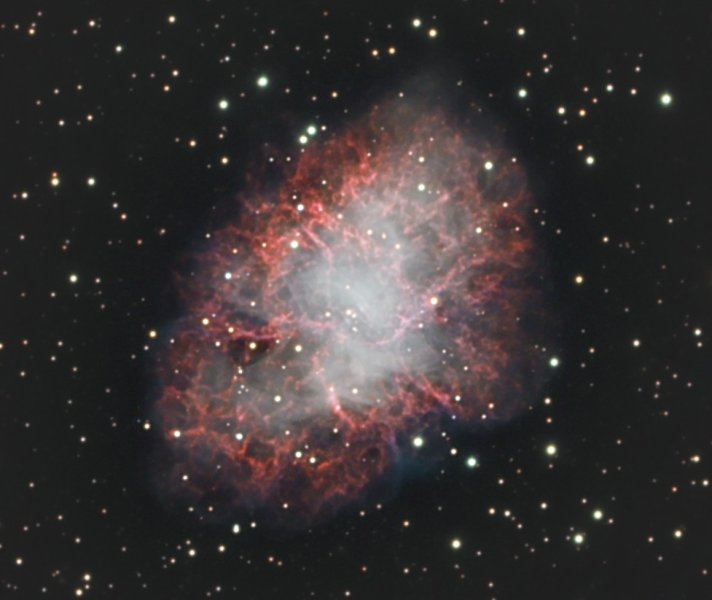M1, the Crab Nebula |
 |
| In the year 1054 AD a brilliant star lit up the
night sky in the vicinity of the constellation Taurus the Bull
and shone brilliantly for 23 days. Unlike the Veil Nebula, this
"super guest star" was observed and documented by astronomers of
the day, most notably Chinese astronomers. It was reckoned to be
four times brighter than Venus, and was so bright it was visible
during the day! It is now known to be a supernova, and today M1,
or the Crab Nebula, stands as the still-expanding rubble that
floats in the space its precursor star used to. M1 is nicknamed the Crab Nebula, which puzzled me as a child because I didn't really see any crab in photos of this object. Only more recently, when I saw this sketch by Lord Rosse did I see the crab. M1 is the most famous and most studied supernova remnant. It is also one of a very few supernovae actually witnessed by humans in our own galaxy. On average, a supernova goes off 1-3 times per century per galaxy. We are apparently long overdue for one, but dense interstellar material within our own galaxy prevents us from seeing a supernova in certain parts of the galaxy. Fortunately, the sheer number of galaxies outside our own allows us to observe supernovae with relative frequency. M1 is also one of the first objects to have a pulsating radio source identified within it (back in 1968), paving the way for a new study of supernova remnants. Coincidentally, its place in the Messier catalog (being the first object listed in Messier's famous catalog) makes it quite an object of firsts! This image was taken from a telescope that I am renting from an individual at New Mexico Skies. It was, in fact, first light for me using that setup. |
| Constellation: Taurus |
| When Visible: November - April |
| Distance: 6,300 light-years |
| Date: January 2009 |
| Location: New Mexico Skies, Mayhill, NM |
| Exposure Details: L: 33 x 10 minutes Binned 1x1 R: 9 x 10 minutes binned 1x1 G: 9 x 10 minutes binned 1x1 B: 9 x 10 minutes binned 1x1 |
| Equipment used: RCOS 10" on a Paramount ME. SBIG ST-10XME with 5-position filter wheel and Astrodon HaLRGB filters. AO-8 adaptive optics unit. Guided using the camera's built-in guide chip and AO-8 unit. |
| Acquisition Software : MaximDL, TheSky6, RCOS TCC |
| Processing Software: MaximDL, Photoshop CS, IrFanView |
